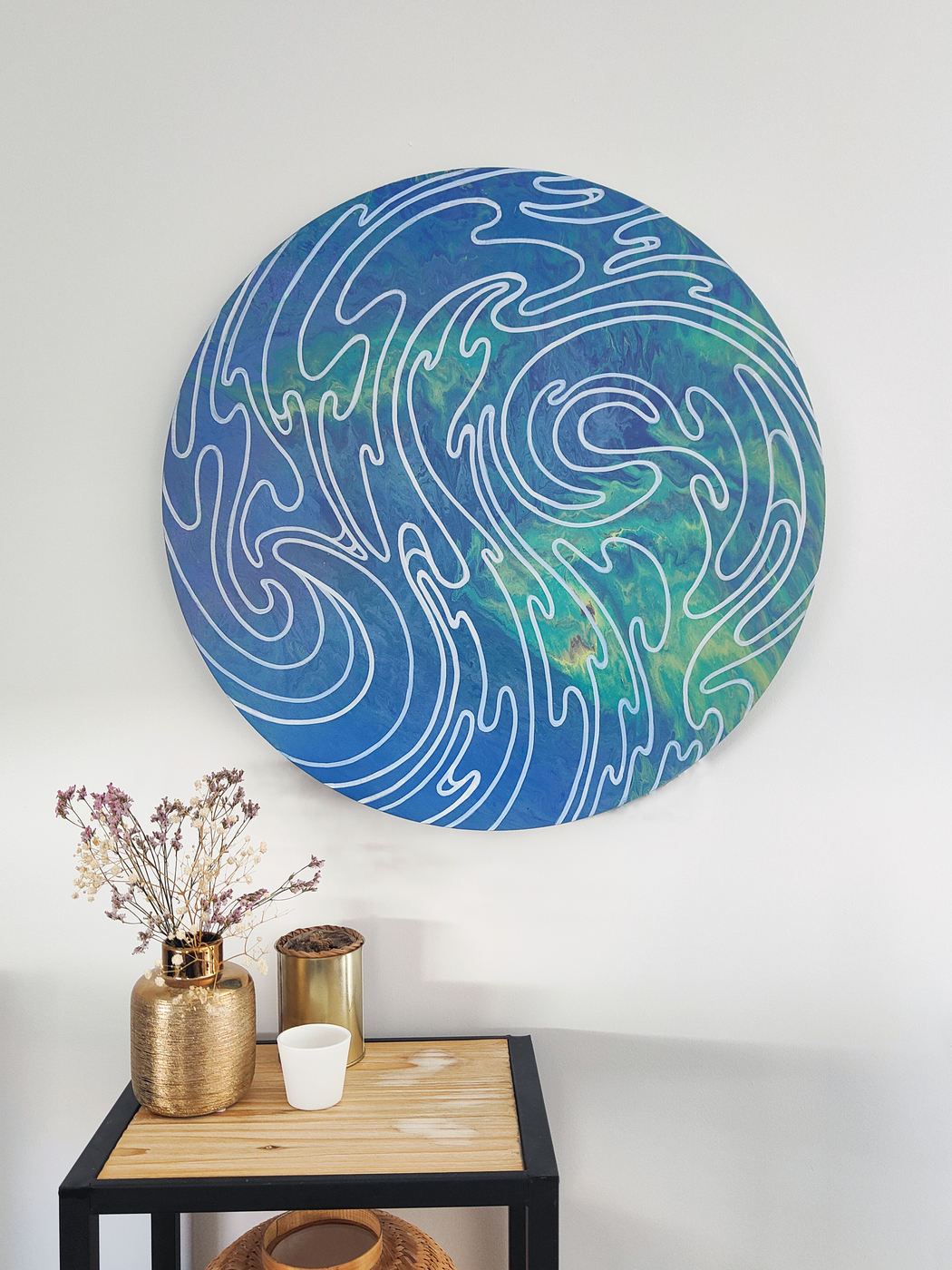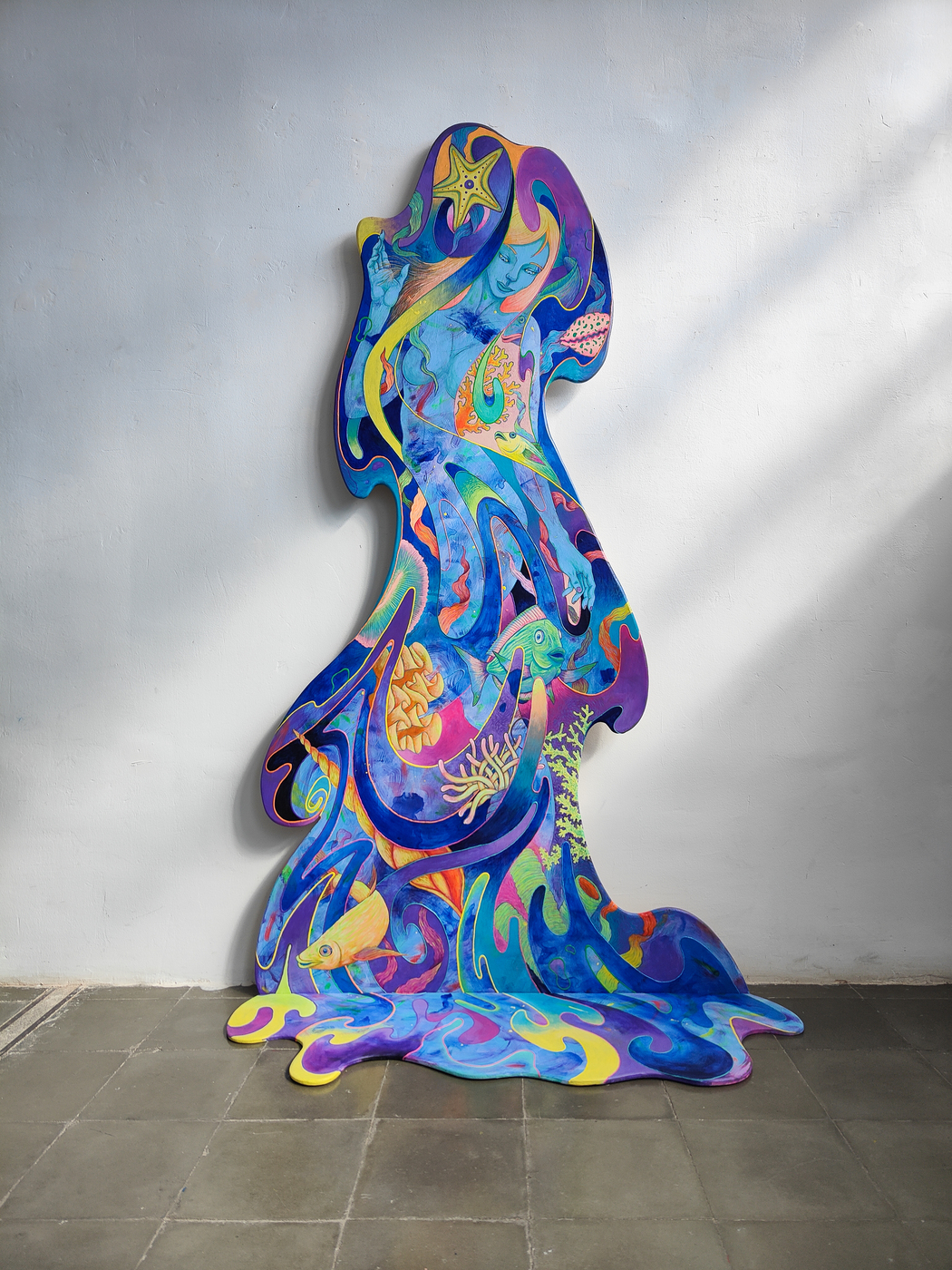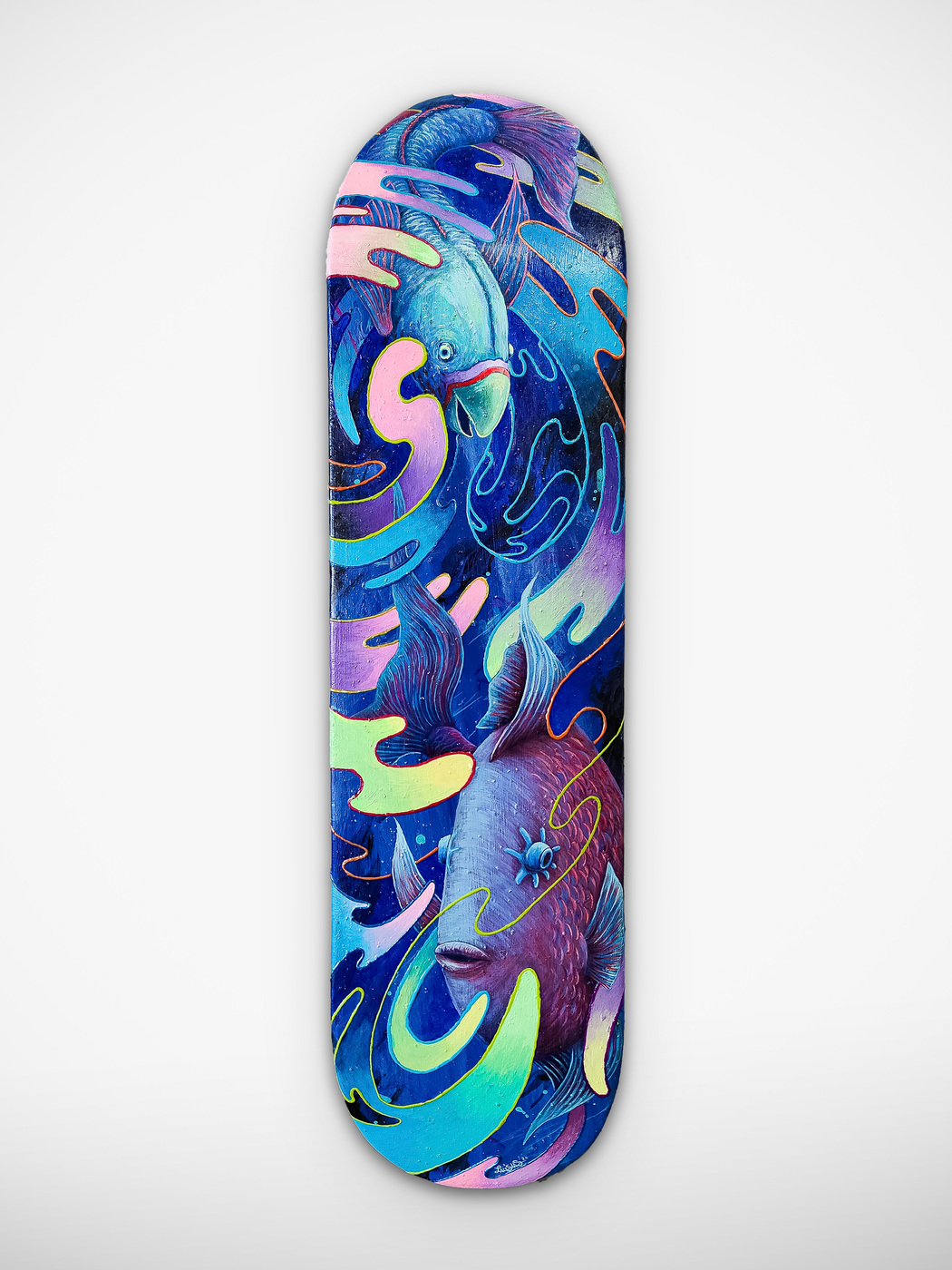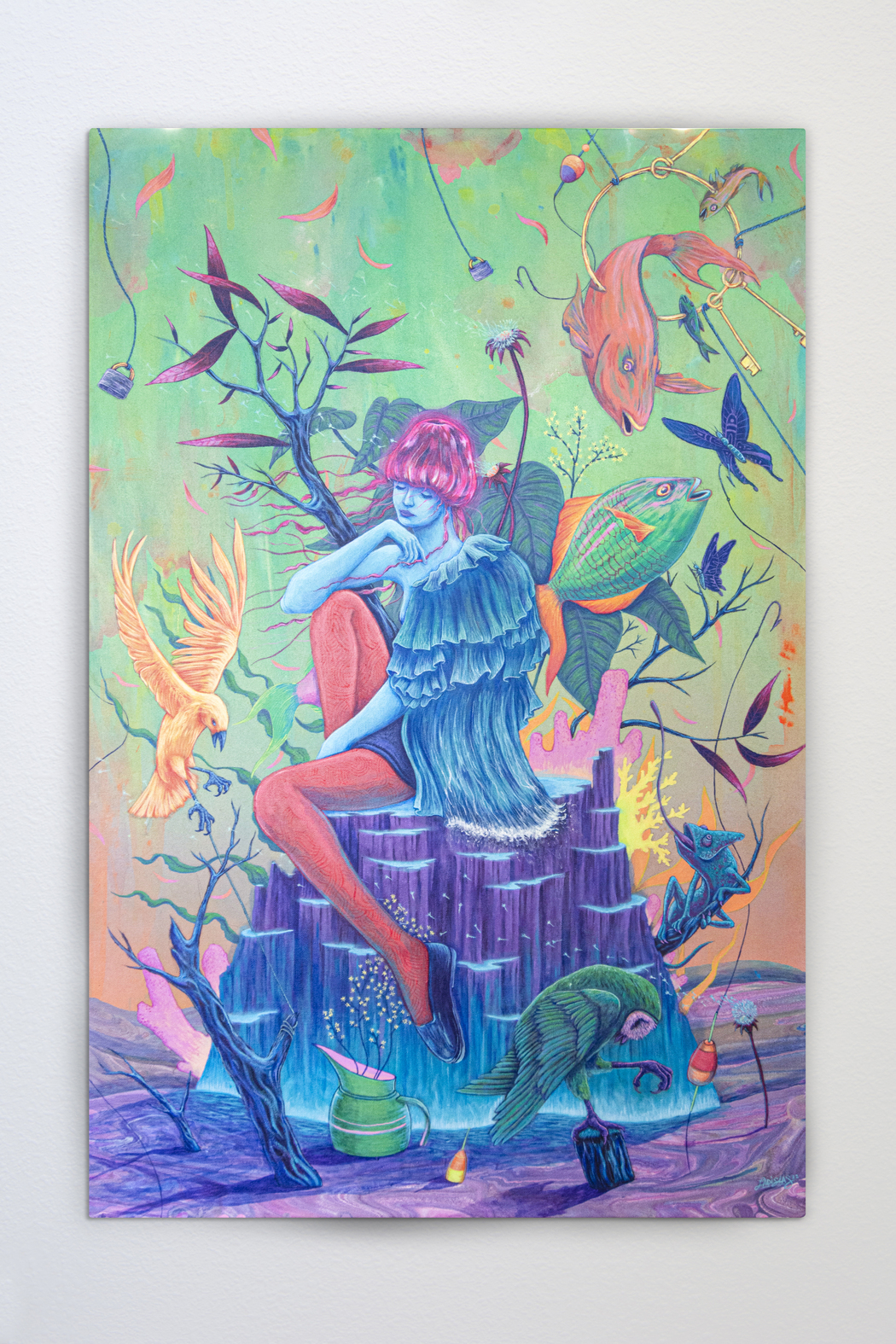Ladislas
Year of birth: 1984.
Where do you live: Barcelona, Spain.
Your education: History of arts in high school + “BA” degree in visual communication.
Describe your art in three words: Fluidity / movement / vibrancy.
Your discipline: Painting / digital art / mixed media sculptures + a bit of installations.
Website | Instagram
Your work merges surrealism with ecological themes, creating what you call “eco-surrealism.” How did you come to combine these two ideas in your art?
I think that this artistic “Imaginarium” that I’m building appeared bit by bit as I was experimenting. In high school when I was studying the history of Arts I discovered classic paintings and was always impressed by the Italian Renaissance paintings ( Botticelli, Rafael or Michelangelo…). The surrealism of Salvador Dalí, and René Magritte were also works that influenced me. This style merged my attraction for figurative paintings + my attraction for dreamlike worlds.
For years, I created and searched for my personal style, focusing on building my technique. The ecology and connection to nature has been something I was interested in since adolescence I guess, but it never occurred to me that I could actually talk about these subjects in my Art.
It was not until I moved to Barcelona to be surrounded by more creatives and artists (in a creative coworking) that my personal illustration projects highlighted this aspect.
The first project I did that mixed ecology nature and surrealism is called “Citizens Of The Jungle”. I spent my childhood and adolescence in a village in the south of France. I was missing this proximity with nature in this new life in the big city, so I started to paint portraits of urban citizens included in some surrealistic jungles made of all sorts of animals and plants. The project started with 1 portrait and I ended up doing 10 portraits for this series. This was the beginning of me finding my artistic voice and personal style that I call “eco-surrealism”.
 Ladislas Chachignot | Circulo Fluido II | 2024
Ladislas Chachignot | Circulo Fluido II | 2024
What role does nature play in shaping the bold colors and intricate patterns in your works?
Nature is like an infinite source of inspiration for humans.
Since we were able to draw on walls in the prehistoric ages, humans have been representing it. I continue to do the same throughout my creations. Nature is very complex, animals, insects and plants are in constant evolution and adapt themselves by developing new features: incredible colors, or patterns. So many things that are always serving as a base for my paintings and creations. It fuels creativity.
How do you hope your artwork will influence people’s perception of the environment and sustainability?
As I’m growing up, I have the opportunity like everyone else to be a witness of our modern societies. We’re living fast and are more a more relying on the digital technologies. We have less time to walk in nature with our busy lives.
This fact is directly leading most of us to a great disconnection with the natural world. We start to categorize species, separating animals from human beings. In fact, we’re just other “animals” on this earth, there is no separation possible, but in our minds we got used to thinking there is.
Often, we don’t pay too much attention anymore to the incredible life all around us, the diversity, the richness of all this that is making this planet unique. Through my art, I hope I can operate a sort of “emotional reconnection” of the public with the natural world. I take elements that are existing all around us and combine them in new ways, to spark the curiosity and interest of the public, but also to transmit messages, preoccupations that I feel and things I see in our societies.
 Ladislas Chachignot | Cascade | 2024
Ladislas Chachignot | Cascade | 2024
Could you explain your process when transitioning between digital and traditional media?
Sure, I can say I mainly learned to paint thanks to the digital tools. I was always so amazed by the digital paintings and illustrations. I studied History Of The Art, so I had the chance to discover and watch many classic paintings from many art movements. I always wanted to draw in a more “realistic” way, but I never studied the painting technique in a “fine art”course.
At the age of 30, I remember I was kind of lost, I feared a lot to start and dedicate my energy, money and time to this art journey. I was thinking it was too late to become an artist and do it professionally.
I joined an online community called “Pencil Kings” and the person who was developing this project, “Mitch” convinced me to start following my guts and put some dedication to get better.
I bought a Wacom cintiq 12″ at the time and started to draw daily on the computer, using adobe photoshop. Then I started to add colors, it was easy as there was no canvas to buy, nor brushes or paints… I was able to correct, retouch the drawings and paintings. It felt more secure to fail (many times) and being able to correct my digital painting better and better over the years.
In 2018, I started to explore in parallel to my digital painting, traditional works on small formats A4, A3.
I began to use watercolor and then by using the same technique I was using digitally I started to paint a few small canvases with acrylics. It took me some time to get the skills of painting with real brushes and getting faster with it. But this is a process every artist is going through.
Nowadays, I use the digital and traditional in most of my creation process ( at least for the canvases). I sketch and prepare a composition/color test version on the computer. Then, once I’m satisfied with it, I use this digital sketch as reference for a painting on a canvas or wooden board. My traditional painting is always more detailed and rendered than my digital sketch, but this digital sketch is very important for me.
 Ladislas Chachignot | Le rythme des vagues | 2024
Ladislas Chachignot | Le rythme des vagues | 2024
What challenges or freedoms do you experience in each format?
The digital tool allows me to experiment. I feel safe to try new things, can move each element very easily, and modify things faster. I work with lots of layers, so each element is separated from the others. This is the big plus of the digital tool.
The big plus of the traditional is that I get a lot of pleasure from using real paintings and brushes. I can build more textures, seeing the colors mixing up together. I love the smell of acrylic painting (it doesn’t smell as much as oil), mixing colors on the palette, and having a final object that you can touch, that has subtleties of textures, and brushstrokes. It’s something the digital tool cannot give you, in my opinion.
In your opinion, what responsibilities do artists have when addressing environmental concerns in their work?
Each artist has its own way to create and also its own goal / objectives when it comes to the things he/she wants to transmit in his/her art. Artist has always been some witnesses of our world. And beautiful pieces of art appeared from their minds in every corner of the world, in every era.
The environmental crisis we’re embarked in comes from mistakes of the pasts and behaviors that we have to correct if we want to continue living in a “healthy planet”.
In my opinion (or at least this is what I want to pursue in my career) artists have the power to inspire, question, entertain and interact with the public in a very special way.
Building an emotional connection that is definitely not similar to politics, for example.
In an era where many people don’t trust our politics and governments, art is a tool to show these societies’ problems in some alternative ways.
If an emotional connection can be created with the public, there will be a higher chance that the same public itself will start to spread the message and start acting for the protection of our planet (where governments and many people in power don’t want to operate this necessary change).
 Ladislas Chachignot | The Intricate Ways That Are Leading To Freedom | 2022
Ladislas Chachignot | The Intricate Ways That Are Leading To Freedom | 2022
You’ve mentioned that reconnecting humans with nature is a central goal of your art. How do you approach this concept in specific projects?
Yes, I think this is my main objective and what I hope to inspire when people are staring at my paintings.
To operate this concept I often use humans, animals, and plants in my compositions. I don’t limit myself to the “laws of physics”, that means for example in a painting I can mix fishes with birds. I represent this world as a whole, not the perception we have of it, with rules and laws that goes with this.
I’m creating situations where these characters are interacting with the environment. To question to public and to open within themselves reflections about what they’re seeing, what’s their interpretations of it.
Then with some small guidance, I can put the focus on the significance of some elements of the painting.
But it’s also important to leave a wide space for personal interpretation. It’s like this that people can search within their emotions, what they’re feeling by exploring the painting.
By showing these surrealistic sceneries I show them elements they probably saw somewhere in a new way. This might spark curiosity, and attention to question themselves about what they see. Giving them the motivation to learn more about these creatures and plants, and see the beauty of nature transcripted and interpreted through the artist’s scope. All this can lead to an emotional reconnection with nature, and the necessity to immerse yourself within it and experience it.
As a self-taught artist, what advice would you give to aspiring artists who are exploring digital painting or eco-art?
I would say a few things that I discovered over the years :
1) Each artist has its own way of tracing its path in the art world. There are many people out there who are saying they can sell you the secrets to be a successful artist. I recommend that you follow in priority your “inner voice” and personal taste when creating your art. It’s important you connect with peers and learn from people who are also following an artistic path but don’t get their words for sacred speeches.
2) Your path will appear while you’re committing to the creation (can be pursued as a hobby or professionally). Passion is what is sparking the fire. Commitment and repetition is what build the artist. Patience and resilience over difficulties are quite important. I always see this artistic life as a marathon, not a speed race. If you intend to pursue the professional. Path, and sacrifices along the way might be necessary in order to dedicate yourself to this passion career.
3) Eco-art is still something a bit unconventional when it comes to art creation. So if you feel you’d like to explore these thematic, you should see yourself as a kind of adventurer who is exploring new places. Explorers sometimes feel they’re lost or don’t know which path to take. Sometimes there’s no clear path. Your mission is to trace one.
4) In my opinion, I suggest you be true to yourself, you’ll meet people who will understand your art and some others won’t. But you should create what you really like as much as possible to get good at it. I think this is how your artistic identity will appear by itself with time.

Pingback: Visual Art Journal #10 interview - Welcome on Ladislasdesign.com surrealism / Digital Painting / Artivism by Ladislas Chachignot